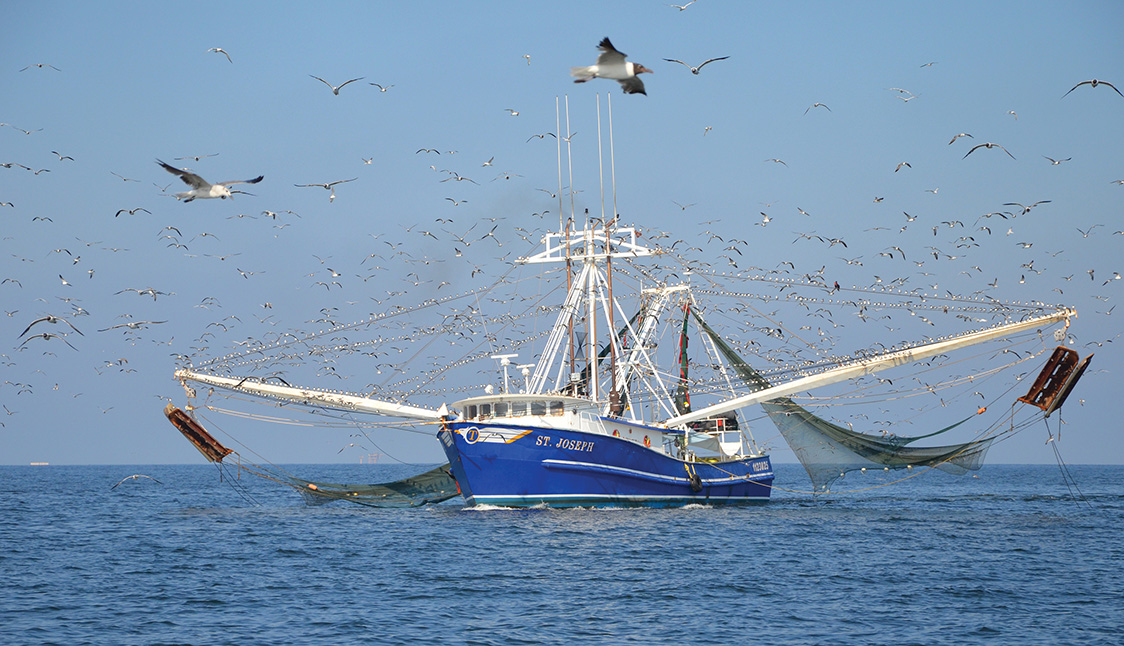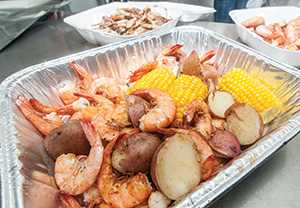
Bringing our most popular seafood from the ocean to the plate
By John N. Felsher
Storms, pollution, soaring fuel prices – shrimpers must contend with these factors and many more to bring succulent crustaceans to market. But most would rather do nothing else.
“Our family has been here since the early 1700s,” says Greg Ladnier, owner and president of Sea Pearl Seafood in Bayou La Batre. “We’ve always been involved in seafood. I started shrimping with my uncle when I was 10. I ran a boat for a year before I went to college.”
In 2014, the state licensed 735 commercial shrimp boats, compared to 697 for 2009, the year before the massive oil spill in the Gulf of Mexico. Smaller “ice boats” with a captain and a deckhand go out for a day or two. They put their catch on ice and return to port before the ice melts.
Larger boats carry equipment to freeze their catch. They may stay out 30 to 50 days, depending on how long it takes to fill their holds with shrimp or how much fuel and supplies they can carry. A big offshore boat might carry a captain and a crew of four to six.
“Larger boats travel all over the Gulf to chase shrimp,” says Chris Blankenship, director of the Alabama Marine Resources Division on Dauphin Island. “They might start out in Alabama, but when Texas or Louisiana waters open to shrimping, that’s where they go. Beginning in 2016, shrimping will close in all inside waters from May 1 through June 1. Previously, we opened shrimp seasons when most shrimp reached the 68 shrimp per pound size.”

In addition, the state licensed 958 recreational shrimpers in 2014, Blankenship says. Recreational shrimpers catch shrimp for their own consumption and cannot sell them. By Alabama law, they can only use a trawl 16 feet long or less. They can only keep one five-gallon bucket of shrimp per person per day.
Shrimpers mainly catch two species – brown and white shrimp. Both live in the marshes and estuaries and migrate to the Gulf to spawn. Recently named the official crustacean of Alabama, brown shrimp spawn in the winter. White shrimp spawn in early summer.
“After shrimp spawn offshore, the larvae float with the tides and come back into the bay and estuaries,” Blankenship says. “Marsh grass and little bayous are vital to shrimp development. They need places to hide because everything likes to eat a shrimp. In the marshes, shrimp grow until they are large enough to move out to the Gulf and start the cycle all over again.”
When a loaded shrimp boat docks at a processing plant, the captain sells the catch. Larger shrimp bring in more money per pound. With money in hand, the boat captain pays the crew and resupplies the vessel for the next trip out.
“Shrimp landings have been down for a few years, but the value is increasing,” Blankenship says. “In 2014, Alabama shrimpers landed 17.6 million pounds with a total dockside value of $58 million. In 2009, before the oil spill, they landed nearly 22 million pounds valued at about $32.5 million.”
After buying the shrimp, the processor prepares the crustaceans for human consumption. Processors freeze much of the catch in 5-pound blocks for shipping to restaurants all over the country.
“If the boat brings the shrimp in with the heads on, we can take the heads off or sell them heads-on,” Ladnier says. “We run some through peeling machines and can sell them either deveined or with the veins in them. At that stage, we can freeze them in nitrogen with an individual quick frozen system or cook them.”
Before shrimp can go to restaurants, inspectors check them for bacteria, chemicals, microbes and other things. After the 2010 oil spill, checking for petroleum contamination became more important.
“Seafood coming out of the Gulf has always been excellent quality,” says Brett Hall, deputy commissioner of the Alabama Department of Agriculture and Industries. “We’ve never had an incident when Gulf shellfish has not passed inspection. For the last five years, the seafood has been outstanding.”
According to the Alabama Seafood Marketing Commission, Gulf Coast fishermen catch more than 69 percent of the shrimp landed in the United States. Unfortunately, only a small percentage of shrimp sold in American restaurants come from American waters. Most shrimp sold in restaurants comes from Asia.
“Probably about 93 percent of the shrimp sold in the United States comes from overseas,” Blankenship explains. “The Alabama shrimping industry is not as big as it was two decades ago, but it will always be around.”
Shrimp remains the most popular seafood sold in the United States. The average American eats about 4.1 pounds of shrimp per year, but Gulf Coast consumers may skew that number. Chefs can prepare the delicious morsels in infinite ways or add shrimp to any delectable concoction.
 John N. Felsher is a freelance writer and photographer who lives in Semmes, Ala. He co-hosts a weekly outdoors show that is syndicated to stations in Alabama. For more on the show, see www.gdomag.com. Contact him through his website at www.JohnNFelsher.com
John N. Felsher is a freelance writer and photographer who lives in Semmes, Ala. He co-hosts a weekly outdoors show that is syndicated to stations in Alabama. For more on the show, see www.gdomag.com. Contact him through his website at www.JohnNFelsher.com





